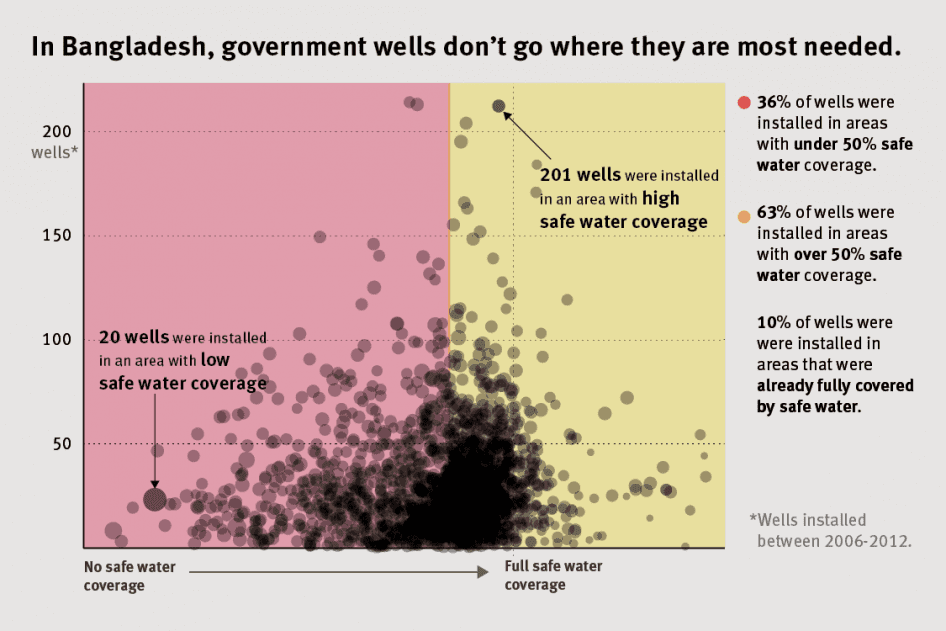Arsenic was a favorite poison among murderers for a long time because of its lack of odor and taste, and until the mid-19th century it could not be detected in corpses. Large quantities of arsenic can kill a person very quickly. However, a risk faced by millions of people every day is the slow and steady exposure to arsenic, which causes several long-term health issues. Bangladesh, the 10th most densely populated country in the world, is facing a large scale threat from arsenic contamination right now.
High levels of pollution have contaminated surface water sources in Bangladesh, resulting in an increase in the number of people affected by gastrointestinal and other water-borne diseases. To avoid getting sick, more and more people have switched to groundwater. However, Bangladesh lies on the Bengal delta, which gets sedimentation deposits from three large rivers. This delta, over years and years, has become very rich in arsenic deposits.
Arsenic can also reach the human body through food. Rice happens to be a staple crop in Bangladesh, and also is very effective in the uptake of heavy elements like arsenic. Another way rice contributes to arsenic consumption (apart from direct grain consumption) is through the rice husk, which is fed to cattle. Humans in turn will consume milk and meat produced by the cattle. Experiments have shown that rice husk contains more arsenic than other parts of the plant.
Arsenic contamination is a very real and serious threat. A recent report by the Human Rights Watch said that 20 million people in Bangladesh are still affected by water containing arsenic. The World Health Organization (WHO) and the Bangladesh government have tried to take several efforts to decrease the reach of arsenic contaminated water.
Groundwater is currently accessed via tube wells. Tube wells are formed of long pipes drilled deep into the earth with a hand pump attached to them from which the water is brought up. Efforts include building new tube wells in areas with lower arsenic contamination and tagging those tube wells that pump out water containing more than a safe limit of arsenic. The report concluded from extensive research and interviews that these measures have not been very effective, both due to a lack of awareness among the people and an ineffective planning when building new wells. The figure below shows that new wells aren't being built in the areas that need them the most- the areas where no other form of safe water is available.

According to WHO, long term exposure to this element can cause cancer, skin lesions, heart disease, diabetes, and also have detrimental effects on development. Contamination of drinking water was found to reduce children's intellectual capabilities according to an extensive study conducted in Bangladesh in 2004. Two hundred children from different regions with different levels of arsenic exposure were tested for intellectual capacity according to the Wechsler Intelligence Scale for children to find this direct correlation.
Solutions are constantly being sought out, and some of the work done already looks very promising. A group of scientists has found a way to genetically modify rice crops to reduce the amount of arsenic uptake by them. There's also a new kind of water filter being developed that can remove arsenic and other toxic metals from drinking water. And, the WHO and the Bangladesh government are constantly being encouraged by environmental awareness and human rights groups to take more steps to spread awareness about this issue. With the advent of these new research projects, as well as increased awareness, there is hope for change in the near future.
About the Author
 Sunishka “Suni†Thakur is a junior majoring in Genetics. She is passionate about science education awareness and is involved with the Science Olympiad tournament held here on campus as a way of encouraging high school students to pursue science education. She aspires to go to graduate school and do research in the field of evolutionary biology. More from Sunishka Thakur! Sunishka “Suni†Thakur is a junior majoring in Genetics. She is passionate about science education awareness and is involved with the Science Olympiad tournament held here on campus as a way of encouraging high school students to pursue science education. She aspires to go to graduate school and do research in the field of evolutionary biology. More from Sunishka Thakur! |
About the Author
- athenssciencecafehttps://athensscienceobserver.com/author/athenssciencecafe/April 17, 2020
- athenssciencecafehttps://athensscienceobserver.com/author/athenssciencecafe/April 12, 2020
- athenssciencecafehttps://athensscienceobserver.com/author/athenssciencecafe/April 3, 2020
- athenssciencecafehttps://athensscienceobserver.com/author/athenssciencecafe/March 30, 2020







